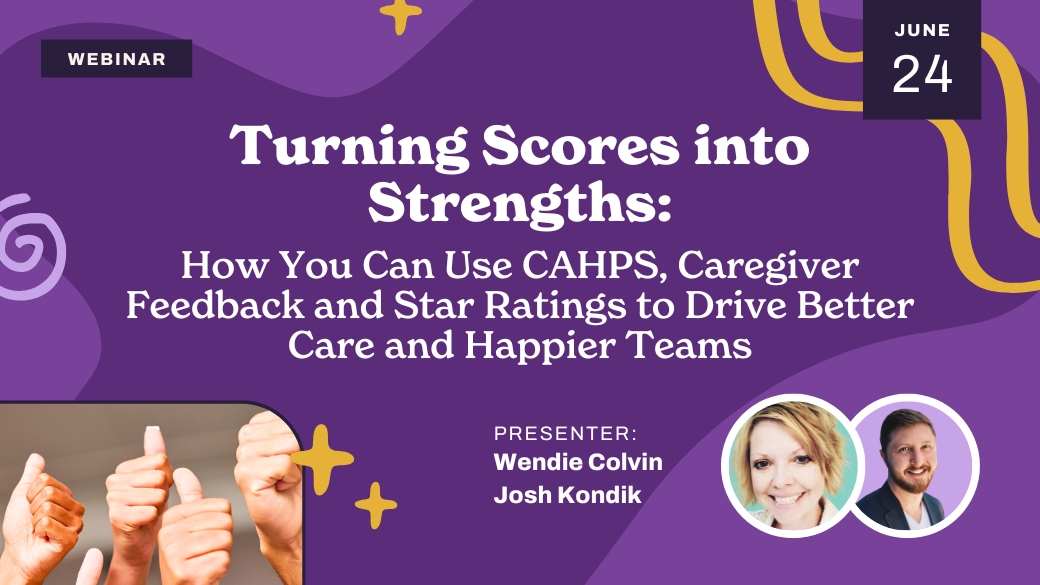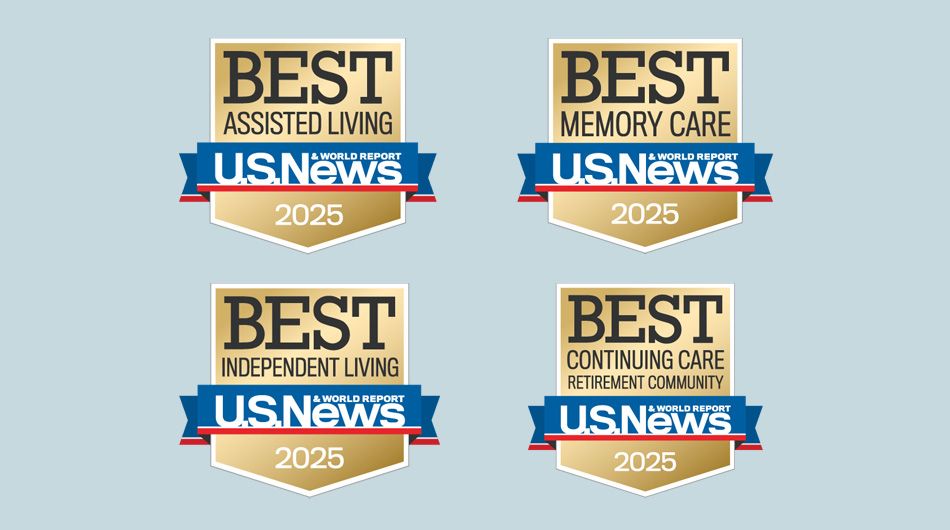Top 10 Complaints About Home Care Agencies from Clients
1 in every 2 clients will end up leaving your agency, but the good news is, we’ve surveyed over 100=,000 clients to find out why. Learn what your clients are saying about your agency behind closed doors and what they wish you’d do to improve.
What your clients think about you generates over 35% of your agency’s total income, making their opinion worth $582,700. However, less than half of those clients are satisfied with your agency’s service.
If you’ve ever wished you could be a fly on the wall to listen to what your clients are saying about you to their friends: you’re in luck. We survey over 9,000 pre- and post-acute care clients every month to reveal their most common complaints, and in this article, we’ve included actionable steps you can take to resolve these complaints and improve the quality of your care for your clients.
Find out what your clients want you (and your staff) to do differently as we count down to their number one complaint:
Complaint #10: Being treated like a job instead of a friend.
While it’s in the job title, it’s a practice that is easily taken for granted in the field: “care.” Clients are looking for more than just basic healthcare; they want companionship that makes them feel less like a checklist and more like a friend. Even if your caregivers are checking all the boxes of their job description, your clients want to feel like more than just a task to be completed.
As caregivers are often the only social interaction a client receives, caregivers have the unique opportunity to not only help their clients feel less alone as they work, but to build life-changing relationships while on the job. After all, when your agency is hired by family members, they expect that your caregivers will care for their loved ones with dignity, respect, and compassion. This includes friendship and building trust.
This process begins with bridging the generational gap between client and caregiver. Whenever possible, it’s recommended to assign caregivers to clients that have similar life experiences or personalities, which means it’s essential to build a diverse workforce.
Steps to resolve this:
As 1/3 of the American labor force is made up of Millennial or Gen Z employees, the age difference between most of your employees and clients is no secret. This doesn’t have to be a barrier to trust; your caregivers can still build meaningful relationships with clients regardless of age.
Bridging this generational divide is not only crucial to client satisfaction, but can also be the secret to providing meaningful and fulfilling work outcomes for the rising generation.
The key to resolving this complain is to empower your care staff to build relationships with their clients:
- Start your caregiver’s first impression on a positive note by briefing them on their clients’ care plan. Clearly communicate the client’s expectations so your caregiver is ready to deliver from day one.
- Encourage schedulers to keep notes of their own on each client and caregiver to help them better match personalities.
- Encourage every caregiver to document personal details about each client in their care, such as how they like their eggs done, when they like to read their morning paper, how they like to spend their afternoon, and what types of tasks they expect to be done to guide any caregivers who may need to fill in while the assigned caregiver is unavailable.
- Designate a member of your office staff to contact each client after receiving care from a new employee to assess compatibility, gather feedback about their experience, and record any improvements that their caregiver could make.
- Encourage your care staff to show interest in their clients’ interests, hobbies, and memories by training them in soft skills such as: Customer Service in Healthcare, Building Trust and Confidence, and Enhancing Attention to Detail.
Complaint #9: Care staff that lack accountability.
The little things your caregivers do define your agency’s reputation—and it’s all being done behind your clients’ closed doors.
This is why listening to what your clients experience every day is the only way to know that they’re frustrated with caregivers arriving late, leaving before the end of their shift, or not showing up at all. Because some clients are on a strict schedule, having a caregiver show up late could result in being left unattended or cause an inconvenience for family members who have to stay longer. Plus, this means that they miss out on those extra 10-20 minutes they’re paying for.
According to clients, caregivers are also not completing what is expected of them, are spending most of the time on their phones, and are arriving in unsuitable attire.
Steps to resolve this:
Don’t be left wondering how your employees are acting when you aren’t looking. Train them to deliver polished, quality care before they even step inside your clients’ homes. You should also ensure your employees refresh their knowledge with regular training, whether that’s every six months or once a year.
Making your employees accountable for their actions starts by clearly communicating the quality of care your agency expects:
- Prioritize soft skill training: Soft skill training has never been as important in the workplace as it is in environments where you don’t see your employees every day. When you consider the generational gap between employee and client, teaching simple manners to employees who care for a generation raised on propriety will go a long way. When you make punctuality and personability just as important as the hard skills, your caregivers will begin to do the same.
- Standardize work attire: It’s best practice to require your care staff to wear scrubs or a uniform while in their clients’ homes. This will help your caregivers communicate professionalism and consistency on behalf of your agency. Offering branded company clothing that can be used while on the job will also add a personal touch and give your caregivers a variety of company-approved attire to represent your agency.
- Get a second set of eyes: Hold demonstration performance reviews where a caregiver’s mentor or supervisor attends a caregiver’s shift to give them feedback on what they’re doing well and what improvements they need to make.
- Keep following up with your clients: The only way you can know if your employees are embodying your agency’s mission is by asking the ones they care for. Make it easy for your clients to be heard by contacting them to gather their feedback and hear their concerns on a regular basis.
Complaint #8: Unmet expectations and confusion in the type of care they can expect.
Clients are finding their desired tasks are being left uncompleted, and they’re tired of being assigned caregivers who wait until they’re told what to do. They feel they are being left in the dark about what they can and can’t expect from their caregivers. Plus, when family members hire a home care agency, they expect someone who can comprehensively take care of their loved ones without instruction.
Although you may know what your agency does, your employees and clients are unsure. Inform your clients of the services your agency provides before they let their assumptions lead to disappointment.
Steps to resolve this:
Miscommunication leads to dissatisfaction. Your employees and clients need to know what your agency expects of them to build a mutually satisfactory and successful relationship.
Clarify your company’s messaging from the start of your clients’ and caregivers’ first interaction with you:
- Clearly outline your agency’s services, specialties, and policies in a written contract: Let your clients know what they’re signing up for and what they can expect from your agency from the start. Before the blame is put on your employees and your agency’s capability is questioned, give your clients and their families a resource that outlines what you can and can’t offer them as an agency. Having a written contract also creates a point of reference for current clients to look back on whenever they have a concern.
- Review the care plan with both client and caregiver to create clear expectations that everyone agrees on: As caregivers perform based off the information provided to them in their client’s care plan, both the caregiver and client should review the care plan before care begins to ensure everyone is on the same page. This will help your clients know what they can expect their caregivers to do for them daily.
- Ensure consistent quality of care by training all caregivers to start on the same level: It’s not just your clients who are confused on their caregiver’s expectations—your employees need to know what their job responsibilities do and don’t entail, too. It’s important to train everyone in: the basics of light housekeeping, your agency’s policy for driving clients to run errands, and what daily responsibilities they are expected to do every day.
Complaint #7: Caregivers who can’t prepare a meal.
While this seems like an easy complaint to skip past, the number of clients who stated they would appreciate if your caregivers had basic cooking skills was staggering. We understand that your caregivers aren’t hired as personal chefs, but when clients lack the ability to feed themselves, they would often appreciate being cared for with a simple dish.
In fact, most clients reported just wanting to be able to rely on their caregivers to make them a grilled cheese sandwich, fry an egg, or prepare a small meal. Meal preparation doesn’t have to be a complicated task that involves complex recipes or multiple courses. Most of the time, clients would even appreciate small snacks.
Steps to resolve this:
Stand out as an agency by training your caregivers in basic cooking skills so they can take care of your clients as if they were their own loved ones. Care staff who learn culinary skills for the workplace improve health outcomes when they are given the tools to manage nutrition for chronic conditions.
Activated Insights Training offers culinary skill training courses that will help your care staff know what types of meals are reasonable to prepare for clients, giving them greater confidence in understanding how to fulfil their client’s needs.
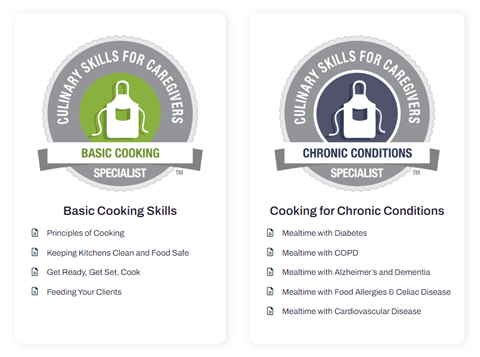
It’s also helpful to equip your caregivers with a few easy recipes, ensuring they have instructions to have on hand to avoid feeling overwhelmed when a client needs to eat.
Complaint #6: They don’t have scheduled care during the hours they need it most.
Many clients complain that their caregiver isn’t scheduled to start their shift until hours after they needed them most, or that the caregiver is leaving before they’ve met all their needs for the day. Above all, your clients want to have access to essential care right when they need it, not when it’s most convenient for your caregivers’ schedules.
As caregiver shortages continue, lack of staffing makes it difficult to ensure there is always someone scheduled to take care of a client during their desired hours.
But before the industry-wide staffing shortage induces further panic, the solution isn’t to hire more caregivers. Instead, strategically place the staff you do have in the hours they’re needed the most.
Steps to resolve this:
Not every client requires care at the same time or during office hours. Listen to your client’s and their family’s needs to determine when they believe care would be the most helpful, and hire employees based on those hours.
In a recent episode of our podcast, Miki Rossanis, Head of Clinical Development at Sensi.AI shares how artificial intelligence technology can help families and agencies determine what time of day a client needs the most help and what kind of physical care they need:
“In one scenario, there was a period of the day where Sensi was picking up on a lot of cognitive anomalies where the client was very confused, forgetful, disorientated, and was making a lot of distressed phone calls to family members.
“By using the Sensi data, they were able to implement physical care with the client’s consent and understanding of when they really needed care. It helped her see that she wasn’t going to have someone with her in her home 24/7, just during the period where there was more difficulty. This provided her with that first step to receiving physical care, enabled the home care agency to make more informed decisions on her care, and put the family at ease knowing that their loved one was being cared for during the period where she really needed it.”
Be sure to personally follow up with your clients to see if their caregivers are showing up during their scheduled hours and to have your schedulers update their preferred hours.
Complaint #5: More than 1 or 2 caregivers are assigned to them.
We get it; it’s hard to match a single caregiver’s schedule perfectly with a client. However, clients are seeking to build relationships with their caregivers and need to be able to trust and get along with the people who come into their home. Having more than one or two caregivers per client can make this difficult, as they are likely seeing a different person each time, making it hard to build real connections with their caregivers.
The issue clients run into is when their regular caregiver can’t make their shift, and they’re assigned someone who isn’t qualified to meet their needs or are left without a caregiver for the day.
Clients want to have consistent caregivers they can rely on to take care of them and who understand their needs.
Steps to resolve this:
While you can’t guarantee that a client won’t see more than one caregiver, fulfilling their needs is a team effort. Your whole team will need to communicate with each other to ensure everyone is up to speed on the types of clients and specialties they may need to work with:
- Use the needs of your current clients as a guide for which topics your entire care staff needs to be trained on: While some factors such as physical differences may present themselves, training your caregivers to handle as many different specialties as possible ensures your schedulers have a larger pool of qualified caregivers to choose from while matching them to a client.
- Have your schedulers prepare a few best-fit caregivers for each client: While an employee calling in sick is frustrating to your clients, it can be even more frustrating to your schedulers, who are now in charge of finding someone to cover their shift. Have your schedulers prepare for caregiver absences by having a list of 2 or 3 back-up caregivers who match the needs and personality of each client. That way, instead of just trying to fill a shift, they will have a prepared list to reference with the best options available.
- Prepare for substitutes by implementing better caregiver documentation: Nothing is more frustrating than expecting your regular caregiver only to have a rotation of employees entering your home, especially when the new caregivers need to be briefed on what usually occurs during the visit. While all substitute caregivers should review a client’s care plan before entering their home, those assigned to the client should record little details and preferences only they know about their client to ensure their client is taken care of while they’re unavailable.
- Introduce new caregivers to avoid blindsiding the client: If a caregiver is entering a client’s home for the first time, set them up for success by preparing your client for who is about to knock on their door. Ensure all caregivers who are visiting a client for the first time review the client’s care plan beforehand and introduce themselves upon meeting to smooth out any hesitancy or discomfort your client may feel towards them.
Complaint #4: Their care plan isn’t taken into consideration when being matched with a caregiver.
Imagine you need someone with physical strength to lift you in and out of bed, but to your surprise, you’re assigned a petite caregiver. Unfortunately, this isn’t a hypothetical scenario; this is reality for many home care clients. When family members request home care for their loved ones, they expect a caregiver that can meet the unique needs of their loved one.
Client experiences are riddled with instances like this, to the point where someone reported, “They just send me warm bodies.”
Steps to resolve this:
Deliver what your clients deserve and are paying for by matching your caregivers’ abilities to their needs. Schedulers are critical to this process, and can help deliver what your agency promised:
• Train your schedulers to pinpoint training gaps while matching caregiver to client: Your clients’ qualities should match your caregivers’ abilities. If your schedulers are running out of caregivers who can match the needs of your agency, ensure you’re only taking on clients you have the staff to care for. It’s also good practice to have your schedulers sit in on caregiver interviews to provide insight into who can fulfil the needs of your current clients.
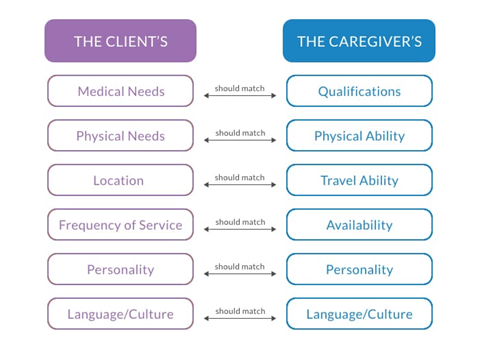
• Expand your pool of qualified caregivers with specialty learning paths: Clients are specifically looking for caregivers with specialized training in Alzheimer’s, Dementia, and Parkinson’s. Train your caregivers in the following specialties to serve clients that other agencies can’t: Alzheimer’s, Dementia, palliative care, behavioral health, infection control, reducing readmissions, and restorative care. Incentivize caregivers to advance their training by increasing their pay when they complete training as you guide them along your agency’s career path.
Complaint #3: Hard to reach office staff.
Believe it or not, when your company doesn’t communicate as a whole—your clients notice. It’s like calling a store to see if they’re open, only to get sent to voicemail. Frustrating, right?
Clients and family members have told us that they often don’t know who to contact to reach your agency and are finding it difficult, if not impossible, to get ahold of someone at the office when they have questions or concerns. They expressed frustration with needing to jump through hoops and work their way up a complicated chain of command just to get answers in a timely manner.
As a result, many clients attempt to contact their caregiver directly or end up calling family members who hired your agency to help in the first place.
Steps to resolve this:
There is no such thing as overcommunicating. Your clients need to know who they should contact regarding each issue that they may encounter, such as caregiver concerns, billing, scheduling issues, or other questions. Plus, they need a reliable way to contact your agency in the event of emergencies or urgent questions.
Enhance your company’s internal communication and provide a smoother process for your clients to contact you before you let their cancellation go to voicemail:
- Contact your clients before they need to contact you: Head off any problems by contacting your clients once a month to check in and follow up with any questions or concerns they have.
- Create a company-wide policy for response time: Set expectations for how long a message should go unanswered. Establish that all emails be responded to within 1 business day and that voicemails should be checked, and responded to, periodically throughout the day.
- Train your office staff in telephone etiquette: Approach the phone ringing as if someone was waiting in the lobby to be helped, and always try to answer the phone within the first two rings. You should also have the caller’s records, care plan, notes, or schedule pulled up in front of you.
- Hire someone to answer office calls during off-hours: Agencies who have someone answering calls after hours are noticing their client satisfaction skyrocket, as caregivers can communicate scheduling issues before the office is already open and clients can receive help with problems when the office isn’t busy during regular hours.
- Ensure your entire care staff fills out their shift notes: It’s not enough for just a caregiver to know how their shift went. Ensure your office staff has access to caregiver shift notes so that those in the office know what happened in the field while talking to clients.
Complaint #2: Not being notified of schedule changes.
There doesn’t seem to be an end in sight for the number of clients who have experienced their caregiver not showing up for a shift without being notified. Clients are being left for the day or weekend without hearing from anyone from their agency, panicking family members who relied on someone to be there for them. Beyond being unprofessional, this can create unnecessary stress and anxiety for clients and their loved ones.
Steps to resolve this:
Because this is such a common client complaint, it’s up to you as the agency owner to address the obstacles that are causing your office and care staff to avoid communicating schedule changes. There are a few ways to achieve this:
1. Train your schedulers:
- Reassure your schedulers that you understand the daunting task of being a caregiver’s messenger while delivering schedule changes to clients. Once you do this, you should equip them with soft skill training to help them confidently manage conflict and handle complaints.
- Have your schedulers notify clients about schedule changes with as much notice as possible and send frequent updates to keep them in the loop as they look for a replacement.
- If a client’s usual caregiver can’t make it, ensure they’re matching their replacement’s abilities to the needs of the client’s care plan.
- Have schedulers brief both the client and the caregiver on who they can expect to work with/receive care.
- Never leave schedulers stuck in a situation where they don’t have a caregiver to send to a client. Prepare for schedule changes by encouraging them to have a list of backup caregivers for each client who understand the client’s care plan and can fill in when necessary.
2. Keep your caregivers accountable:
- Before hiring a caregiver, check to see if their schedule availability fits your agency’s needs. If not, it may be best to find a different candidate that can fill any schedule gaps you’re facing.
- Ensure your employees know who to contact if they ever need to call in sick and be sure to set expectations for how far in advance they need to request time off.
- Train your caregivers on notetaking after each client visit so any caregiver can step in, stay up to date, and be ready to execute their client’s care plan.
- Check in with your caregivers to see what changes can be made to make their schedule more manageable before absences become a problem.
Complaint #1: Caregivers are sent into their homes without adequate training.
A client’s home should not be your caregiver’s first training room, and we’re not the only ones who think that.
The number one complaint from clients is when an agency’s care staff don’t seem to be prepared to take care of their needs.
Your clients notice when your employees don’t feel confident in fulfilling their job responsibilities. What they want more than anything are caregivers who know how to execute the details in their care plan and who understand what needs to be done before entering their home.
Steps to resolve this:
To ensure everyone is delivering consistent quality care on behalf of your agency, all your caregivers need to have enough training to feel confident in their role before their first scheduled shift in the field.
Your commitment to training all employees to a high standard, despite previous experience level, will expand the pool of qualified care staff your agency can rely on to help you take care of more clients at a higher quality standard. A trained, competent staff makes your clients feel valued and ensures that there are no gaps in the quality of care your agency can provide.
Train your caregivers in the following basics to equip your employees with the skills they need to confidently care for your clients:
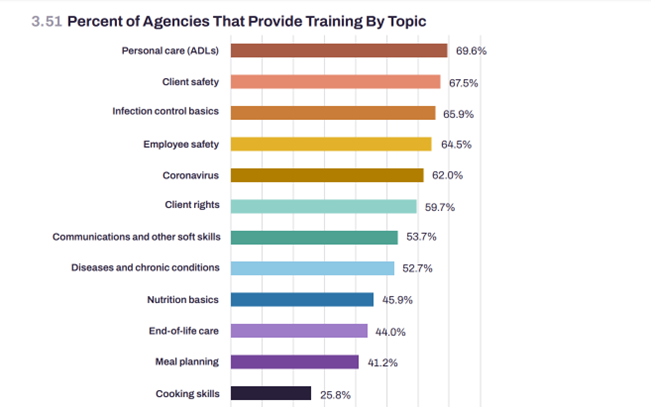
Complaints Can Be Your Agency’s Blessings in Disguise
Knowing your clients’ top concerns allows you to resolve them before they cause clients to leave your agency. Complaining isn’t always a bad thing, especially when it comes to understanding the pre- and post-acute care industry. If you don’t know the good, the bad, and the ugly about your agency, you’ll never know what you could do to improve. That’s why it’s essential to continuously collect feedback from your clients and staff. Activated Insights can help you do this with our Experience Management program. Every month, our staff surveys your clients to determine how satisfied they are with your service, helping you gain real-time insights that can be used to improve your agency in areas that mean the most to your clients.
Plus, with Activated Insights Training, you can train every department within your agency to turn your clients’ number one complaint into your agency’s best asset. To learn more about how Activated Insights can help you enhance your care quality, contact our experts today.
Learn More About Client Satisfaction in Home Care
• How to Use Your Net Promoter Score Like a Pro to Reverse Client Turnover—No Matter Your Results
• The Ultimate Guide to Caregiver Training in 2022
• How to Avoid Losing Clients to Senior Living
Related Posts




